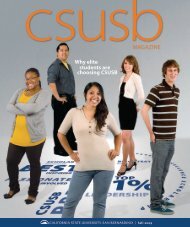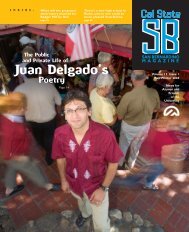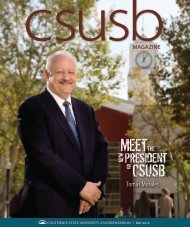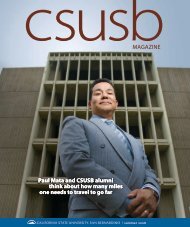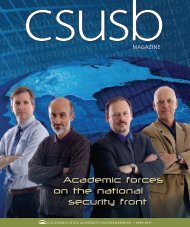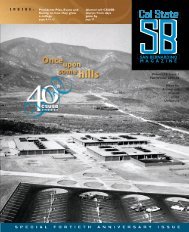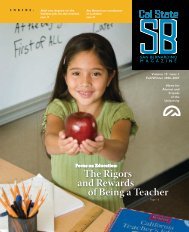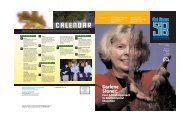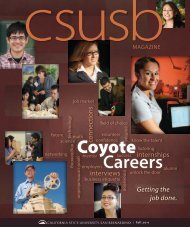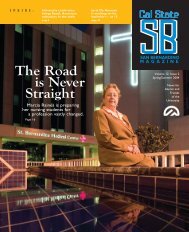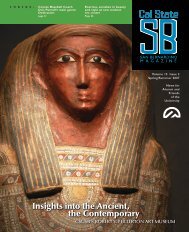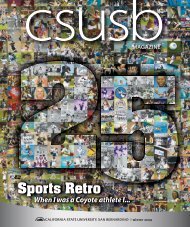CalMagSpr05 ind.indd - CSUSB Magazine - California State ...
CalMagSpr05 ind.indd - CSUSB Magazine - California State ...
CalMagSpr05 ind.indd - CSUSB Magazine - California State ...
- TAGS
- csusb
- magazine.csusb.edu
You also want an ePaper? Increase the reach of your titles
YUMPU automatically turns print PDFs into web optimized ePapers that Google loves.
C O L L E G E N E W S<br />
Eri Yasuhara, dean . . . . . . . . . . . . . . . . . . . . . . . . . . . . . . . . . .<br />
Designed primarily for future<br />
and current teachers at the high<br />
school and community college<br />
levels, the master’s degree program<br />
in Spanish made its debut<br />
in January after needs assessments<br />
showed strong public support<br />
— especially among educators<br />
— for the program.<br />
“As a Hispanic Serving<br />
Institution, <strong>CSUSB</strong> now can<br />
greatly expand its ability to<br />
serve the needs of the Spanishspeaking<br />
community in our service<br />
area,” said Dan Whitaker,<br />
<strong>CSUSB</strong> Spanish professor and<br />
coordinator of the new master’s<br />
THE LID OF NETER HENEB<br />
FINDS A HOME<br />
The coffin lid of the mummy of Neter Heneb had floated about private<br />
collections since the 1950s, never quite f<strong>ind</strong>ing the k<strong>ind</strong> of stability<br />
every coffin lid needs. But this past October the lid received a new lease<br />
on life after <strong>CSUSB</strong>’s Robert V. Fullerton Art Museum purchased it with<br />
the aid of lovers of ancient art. The soft buzz created by the purchase is<br />
due primarily to the lid’s age — a 2,500-year-old artifact that’s now on<br />
exhibit in the RVF.<br />
In the case of Neter Heneb, age comes not before, but with beauty.<br />
Shaped like a human body, the coffin lid is about 6 feet tall and made of<br />
several thick Lebanese cedar planks which are covered with fine linen and<br />
decorated over a striking yellow background. The face of the deceased,<br />
painted in rich red-ochre tones, <strong>ind</strong>icates that the coffin was made for a<br />
male. Female faces were typically done in a pale yellow. A double row of<br />
vertical hieroglyphic text below the rich floral broad collar covering the<br />
upper part of the body gives the name of the coffin’s occupant, “Neter<br />
Heneb.” According to the inscriptions on the lid, a coffin was made for<br />
Neter Heneb because he’d done his fair share of offering geese and oxen<br />
to the temple. The coffin is dated c. 650-300 B.C. “A mummy coffin<br />
like this one,” says Eva Kirsch, director for the Robert V. Fullerton Art<br />
Museum, “has been long desired for the museum collection, and since<br />
2003 the museum had actively tried to locate and acquire one.”<br />
Many museum board members helped purchase the relic. They<br />
include Mr. A. Bertrand Cassan, Dr. and Mrs. Benson Harer, Mr.<br />
and Mrs. Allen Gresham, Mr. and Mrs. Howard Grossman, President<br />
and Mrs. Albert Karnig, Mr. and Mrs. Timothy Martin, Ms. Joanne<br />
McDaniel, Mr. and Mrs. Paul Shimoff in honor of Mr. E. Eugene<br />
Yeager, and <strong>CSUSB</strong> department of art professors Sant Khalsa and Don<br />
Woodford. The university Foundation also helped fund the acquisition,<br />
which was made through a Beverly Hills public auction.<br />
Bringing the ancient coffin lid to the RVF strengthens an already<br />
world-class Egyptian collection, partly on extended loan and partly<br />
owned by the museum. Considered the finest collection of Egyptian<br />
antiquities on the West Coast, many of its objects have been published<br />
in scholarly exhibition catalogs and popular books about ancient Egypt.<br />
Several objects from the collection also have been lent to major exhibitions<br />
organized by major museums. The museum owns close to 100<br />
objects, most of them donated by the Harer Family Trust.<br />
ROLLING OUT A SPANISH MASTER’S<br />
program, which also is open<br />
to students from Cal <strong>State</strong><br />
San Bernardino’s Palm Desert<br />
Campus.<br />
Offered through the university’s<br />
world languages and literature<br />
department, the program<br />
gives students two options, one<br />
in Spanish language teaching and<br />
the other in Hispanic literature,<br />
linguistics and civilization. Fulltime<br />
students should be able to<br />
complete the program in two<br />
years, which is the average time<br />
for similar master’s programs<br />
throughout <strong>California</strong>. About<br />
25 students enrolled in the first<br />
Spanish M.A. class during the<br />
winter quarter.<br />
Spanish master’s degree candidates<br />
are eligible to participate<br />
in the department’s international<br />
programs in México, Perú and<br />
Cuba. <strong>CSUSB</strong> was designated a<br />
Hispanic-Serving Institution by<br />
the U.S. Education Department<br />
in 1999. The title denotes colleges<br />
and universities whose<br />
enrollments consist of at least<br />
25 percent Latino students. Cal<br />
<strong>State</strong> San Bernardino’s enrollment<br />
is almost 35 percent<br />
Hispanic.<br />
Arts & Letters<br />
QUICK TAKES<br />
When 11-year-old Nate’s leg is<br />
crushed in an accident on his<br />
family’s small Nebraska farm, he<br />
is bitterly resentful of the orphan<br />
John Worth, whom his father<br />
takes in to pick up the work Nate<br />
can’t do. John had lost his family<br />
in a New York City tenement<br />
fire. “Worth,” a novel by <strong>CSUSB</strong><br />
English professor Alexandria<br />
LaFaye, is the winner of the 2005<br />
Scott O’Dell Award for Historical<br />
Fiction. A short, sparse novel,<br />
the book tells the Orphan Train<br />
story from Nate’s viewpoint.<br />
Thousands of children were sent<br />
from crowded orphanages and<br />
homes in the Northeast to live<br />
with families on farms throughout<br />
the Midwest from the 1850s<br />
to the early 20th century.<br />
■<br />
Teresa Cotner, assistant professor<br />
of art at Cal <strong>State</strong> San<br />
Bernardino, has received the<br />
Outstanding Higher Education<br />
Visual Art Educator Award<br />
for 2004 by the <strong>California</strong> Art<br />
Education Association. Cotner<br />
won the award, in part based on<br />
her supervisory work with student<br />
teachers and interns, and<br />
also for her efforts in developing<br />
and teaching the first on-line art<br />
class at <strong>CSUSB</strong>. Another award<br />
recipient in recent months<br />
was Kathryn Ervin, chair of<br />
<strong>CSUSB</strong>’s theatre department.<br />
She received a Pioneer Award<br />
from the San Bernardino branch<br />
of the NAACP in December.<br />
A theatre arts professor at<br />
<strong>CSUSB</strong> since 1989, Ervin was<br />
recognized for “bringing the<br />
[theatre] department to another<br />
level in regard to community<br />
awareness,” said Walter Jarman,<br />
president of the NAACP San<br />
Bernardino branch.<br />
7<br />
Spring/Summer 2005 <strong>CSUSB</strong>



